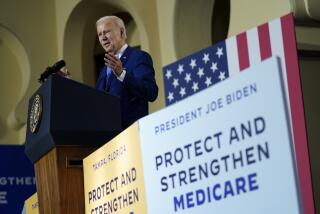Get the HMOs Off the Gravy Train
- Share via
On July 1, the HMO industry announced that it would abandon 250,000 Medicare enrollees on Jan. 1, 2000, and raise premiums or other charges for most of the remaining 6 million seniors enrolled in Medicare HMOs. (The federal government puts the number of abandoned seniors at 327,000.) The industry blamed Medicare, saying that the program does not pay HMOs enough. This is nonsense. Numerous studies have found that Medicare overpays HMOs.
So why are some HMOs pulling out of the program? Because they are inefficient and cannot survive in the Medicare market even with taxpayer subsidies.
Medicare did not deliberately decide to overpay HMOs. The mistake occurred in 1982 when Congress passed a law designed to encourage HMOs to insure more Medicare beneficiaries. The law required Medicare to pay HMOs 95% of the rate at which Medicare reimbursed doctors who treated patients under Medicare’s traditional fee-for-service program. No conclusive evidence that HMOs save money was available in 1982 (nor is there any now). Nevertheless, Congress selected 95% as the reimbursement rate. Just in case this rate was too high, Congress required that HMOs remit the excess to Medicare or offer coverage for things like drugs and dental care that traditional Medicare does not cover.
When the 95% rate took effect in 1985, it became clear that the rate was too high. Instead of returning the surplus to Medicare, HMOs used it to finance coverage for drugs and other services. By 1998, this extra coverage had induced 17% of Medicare beneficiaries to enroll in Medicare HMOs. The 95% rate turned out to be too high because Congress did not anticipate that primarily healthy seniors would enroll in HMOs.
The informal name for enrolling healthy people is “cherry-picking.” At least 15 studies have shown that HMO cherry-picking has been extraordinarily successful. These studies indicate that seniors who enroll in HMOs cost the HMOs 70% to 80% of the cost of insuring the average senior. Yet, from 1985 to 1998, HMOs were paid as if each senior they enrolled cost 95% of the average senior. In other words, the average Medicare HMO was overpaid by 15% to 25%. (In 1997, Congress enacted a law that effectively reduces the reimbursement rate to 92% by 2002.)
If HMOs really were efficient, such a taxpayer overpayment should permit the typical HMO to offer luxurious coverage for little or no fee. But HMOs are not efficient. Yes, HMOs cut medical services, but HMOs rack up large administrative costs to achieve those cuts and to pay for advertising, lobbying and other activities that Medicare does not engage in. Whereas traditional Medicare incurs administrative costs equal to 2% to 3% of its revenue, HMOs gobble up 15% to 30%. For many HMOs, their overhead costs plus the cost of offering richer coverage are roughly equal to the 15% to 25% taxpayer subsidy. A slight increase in costs (caused, for example, by an increase in drug prices) or a slight decrease in the subsidy can force some HMOs to raise premiums or bail out of the Medicare market altogether.
Congress should cut the Medicare reimbursement rate to 75% and plug the holes in traditional Medicare’s coverage, starting with offering drug coverage. If these reforms mean that HMOs can no longer afford to offer coverage that is richer than Medicare’s, and, as a consequence, that seniors abandon HMOs in droves, so be it. Seniors and taxpayers would be better off.
More to Read
Inside the business of entertainment
The Wide Shot brings you news, analysis and insights on everything from streaming wars to production — and what it all means for the future.
You may occasionally receive promotional content from the Los Angeles Times.










